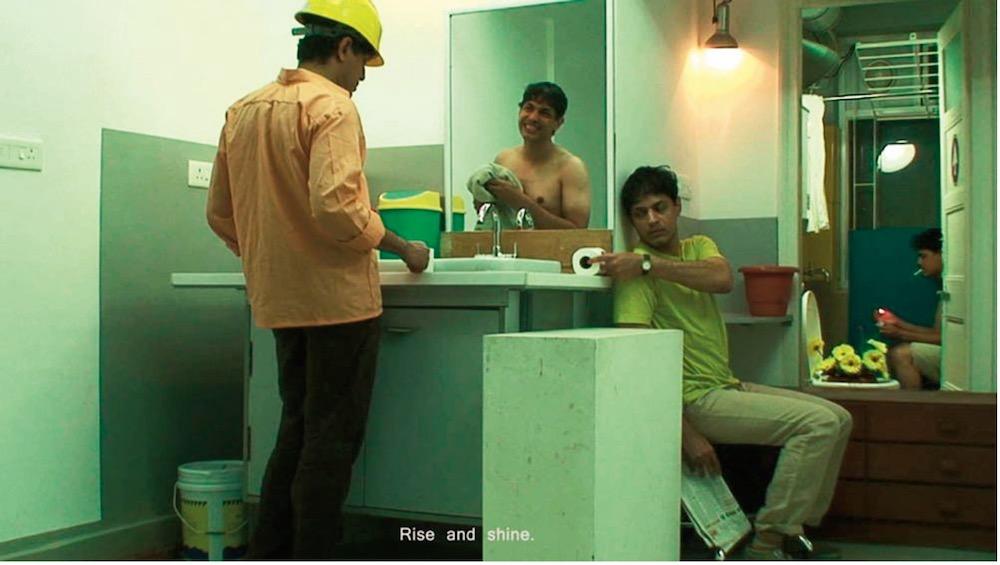Self as Other: The Cinematic Space of Kiran Subbaiah
Kiran Subbaiah’s oeuvre, evolving through diverse media forms—from sculptural to interactive websites and video installations—is often overlooked in the writing of India’s contemporary art history. In his engagement with the photographic and moving image medium, Subbaiah explored subjects that have been at the core of conceptual and avant-garde practice. These include: the figure of the artist, notions of utility and functionality as well as their hegemonies on objects and subjects in modernity. However, he tackles these philosophical ideas with a characteristic banality and a sense of humour. Formally trained as a sculptor at Kala Bhavana, Santiniketan and the Maharaja Sayajirao University of Baroda, Subbaiah went on to study at the Royal College of Art, London and has since been a part of many international exhibitions, earning critical acclaim for his work.

Video Still from Narcissicon. (2009. Single-Channel Video, Forty-Three Minutes. Image courtesy of Chatterjee and Lal.)
In a series of performative videos, like Suicide Note and Narcissicon, Subbaiah appears as doubles of himself: seamlessly conversing, transacting and playing with multiple versions of the image of his body. Working in this vein in the early 2000s, his work was responding to longstanding video art traditions built on the do-it-yourself (DIY) performative model. These videos contain multiple modalities such as textual narratives that sometimes exist as standalone texts, sculptural and architectural formations as well as Subbaiah’s hyper-conscious performance of the body. Combining the three, he constructs densely layered narratives that employ surrealist strategies to displace the viewer’s “fixed” subjectivity.
Hyper aware that his representations of self will be confronted by a future witnessing, he builds a bridge between the multiple temporalities of the author and the viewer through dialogue and direct address. Watching his work on a computer screen, more than a decade after it was made, one is moved to an urgent awareness of the continuities that characterise questions raised by the artist: those of the self, and one’s relation to the self and other in photographic/cinematic media. In an interview, Subbaiah says, “Aesthetics is not my main concern, its appearance in my work is incidental… I rely on the Bauhaus principle to achieve beauty: ‘anything designed to do its job well is bound to look beautiful’.”
Subbaiah employs many theatrical techniques to achieve his desired effect, embedding sculptural constructions in the settings of his videos. Consider for example, Flight Rehearsals, in which Subbaiah appears to be waking up from a dream to the sound of a ringing alarm clock. As he moves to switch the ringing alarm off, he stumbles further than where the clock should be, revealing the alarm clock to be much larger than it appears at first glance. Through these techniques, the artist pokes at the flatness of video as a medium, repeatedly complicating the viewer’s perception of three-dimensional space within it.

Video Still from Flight Rehearsals. (2003. Single-Channel Video, Four Minutes. Image courtesy of Chatterjee and Lal.)
Humour—as it plays out through Subbaiah’s tumbling through cinematic space—is a distilled and concerted effort at thwarting basic assumptions about life and societal relations. We watch him attempting (and succeeding) to fly on the screen, as he talks about this childhood ambition shared by many of us. In a rare video recording of a presentation of his works, Subbaiah is seen casually tapping his camera, addressing it as “you,” the viewer. As the artist’s identity opens up through a considered viewing of his artistic trajectory, the viewer is implicated in each of these explorations. Meaning hovers for a few moments in these mediatic illusions before it is hijacked again by the absurdity of the narratives he constructs.
An archive of some of Subbaiah’s work can be found here.
To read more about Kiran Subbaiah, please search for "Material Inversals: The Works of Kiran Subbaiah" in the Stories section.
All artworks by Kiran Subbaiah.




